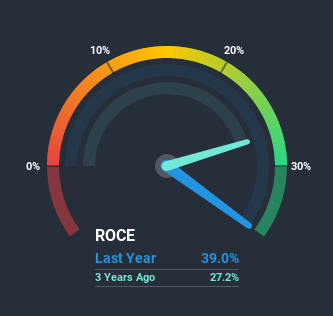Why We Like The Returns At Richards Packaging Income Fund (TSE:RPI.UN)
If we want to find a stock that could multiply over the long term, what are the underlying trends we should look for? Amongst other things, we'll want to see two things; firstly, a growing return on capital employed (ROCE) and secondly, an expansion in the company's amount of capital employed. Put simply, these types of businesses are compounding machines, meaning they are continually reinvesting their earnings at ever-higher rates of return. So when we looked at the ROCE trend of Richards Packaging Income Fund (TSE:RPI.UN) we really liked what we saw.
Understanding Return On Capital Employed (ROCE)
If you haven't worked with ROCE before, it measures the 'return' (pre-tax profit) a company generates from capital employed in its business. The formula for this calculation on Richards Packaging Income Fund is:
Return on Capital Employed = Earnings Before Interest and Tax (EBIT) ÷ (Total Assets - Current Liabilities)
0.39 = CA$83m ÷ (CA$330m - CA$116m) (Based on the trailing twelve months to September 2020).
Thus, Richards Packaging Income Fund has an ROCE of 39%. In absolute terms that's a great return and it's even better than the Packaging industry average of 13%.
See our latest analysis for Richards Packaging Income Fund
In the above chart we have measured Richards Packaging Income Fund's prior ROCE against its prior performance, but the future is arguably more important. If you're interested, you can view the analysts predictions in our free report on analyst forecasts for the company.
What Does the ROCE Trend For Richards Packaging Income Fund Tell Us?
The trends we've noticed at Richards Packaging Income Fund are quite reassuring. Over the last five years, returns on capital employed have risen substantially to 39%. Basically the business is earning more per dollar of capital invested and in addition to that, 57% more capital is being employed now too. The increasing returns on a growing amount of capital is common amongst multi-baggers and that's why we're impressed.
On a side note, we noticed that the improvement in ROCE appears to be partly fueled by an increase in current liabilities. Effectively this means that suppliers or short-term creditors are now funding 35% of the business, which is more than it was five years ago. It's worth keeping an eye on this because as the percentage of current liabilities to total assets increases, some aspects of risk also increase.
What We Can Learn From Richards Packaging Income Fund's ROCE
All in all, it's terrific to see that Richards Packaging Income Fund is reaping the rewards from prior investments and is growing its capital base. And with the stock having performed exceptionally well over the last five years, these patterns are being accounted for by investors. In light of that, we think it's worth looking further into this stock because if Richards Packaging Income Fund can keep these trends up, it could have a bright future ahead.
If you'd like to know about the risks facing Richards Packaging Income Fund, we've discovered 1 warning sign that you should be aware of.
If you'd like to see other companies earning high returns, check out our free list of companies earning high returns with solid balance sheets here.
This article by Simply Wall St is general in nature. It does not constitute a recommendation to buy or sell any stock, and does not take account of your objectives, or your financial situation. We aim to bring you long-term focused analysis driven by fundamental data. Note that our analysis may not factor in the latest price-sensitive company announcements or qualitative material. Simply Wall St has no position in any stocks mentioned.
Have feedback on this article? Concerned about the content? Get in touch with us directly. Alternatively, email editorial-team (at) simplywallst.com.

